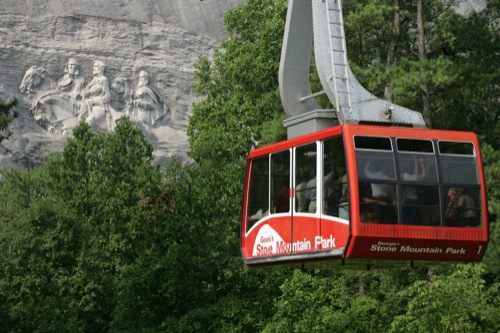
Courtesy Stone Mountain Park
In one year, everything changed for Georgia.
The Civil War had drawn on for several years — longer than anyone had expected — and citizens on both sides were realizing the true cost of conflict. But in the summer of 1864, the world turned upside down for residents of Atlanta and surrounding areas as Union troops overwhelmed Confederate forces and burned the city to the ground.
Although Georgia and the rest of the South have made a remarkable comeback in the years since the Civil War, Gen. William T. Sherman and the Atlanta campaign made a lasting impact on the area. Today’s travelers will find the Atlanta metro region full of compelling stories, beautiful antebellum homes and museums that bring the area’s Civil War history into vivid light.
Historical perspective
The best place to begin exploring Civil War stories is the Atlanta History Center. This museum near downtown Atlanta has a large permanent exhibit called “Turning Points: The American Civil War Experience” that features an abundance of artifacts and a great overview of the Civil War years.
“This is one of the largest collections of Civil War memorabilia on display in the country,” said Brandy Wigley, the museum’s senior manager of community initiatives. “But it also tells the human side of the Civil War.”
The exhibit features all of the artifacts you would expect to find in a Civil War museum — guns, swords, uniforms and the like — as well as more personal items, such as soldiers’ diaries, dice and cards used for entertainment and medical kits used by field medics to tend to the wounded.
Among the most stunning parts of the exhibit is a display of dozens of pieces of “war ordnance,” where visitors can see shells, mortars and cannonballs of intimidating size that were used during the war.
Just as important as the artifacts, though, is the exhibit’s clear presentation of the causes and events of the war. In the beginning, display panels discuss the ideologies behind the war, exploring the philosophies and convictions expressed by parties on both sides.
The exhibit then discusses the various turning points that happened during each year of the war, detailing the important battles and other events that eventually led to Union victory.
www.atlantahistorycenter.com
Memorial in stone
Not far from Atlanta, Stone Mountain Park has one of the South’s largest and most memorable Civil War memorials. The memorial is carved into the side of a massive rock dome that rises from the ground near the city.
“It’s the largest piece of exposed granite in the world,” said Lynn Dondon, specialty markets sales manager at the park. “It’s even bigger than Ayers Rock in Australia.”
On the face of the rock is a giant carving created as a memorial to Confederate soldiers. The carving features images of Jefferson Davis, Robert E. Lee and Stonewall Jackson mounted on horseback. Larger than the carving at Mount Rushmore, the memorial was begun by Gutzon Borglum, the artist who would later go on to carve Rushmore.
Visitors view the memorial from a large terraced lawn at the foot of the mountain. There are 13 terraces on the lawn, each dedicated to one of the Confederate states, as well as Kentucky and Missouri. Each terrace has informational panels about the people from the state and the Civil War battles that took place there.
Many groups that visit the park during the day return at night for the “Lasershow Spectacular,” a light show projected on the face of the mountain that gives an animated overview of the area’s Civil War era and other history.
Battlefield survivor
Because the fighting took place in what is now the thriving city of Atlanta, little of the actual battlefield from the Atlanta campaign remains. But at Kennesaw Mountain National Battlefield Park, visitors can walk the grounds where one of the campaign’s early fights took place.
Although it’s not as large as Stone Mountain, Kennesaw Mountain, near Marietta, made an ideal place for the Confederate troops to stand against the Union armies marching toward Atlanta from the north. Confederates held their ground, forcing Sherman’s troops to fin d another way into the city.
Today, visitors can take a tour of the battlefield, where they’ll find three monuments erected in honor of the soldiers that fought there. From the top of the mountain, accessible by a paved road, groups get a clear picture of the long odds Union troops faced in trying to take the hilltop. On clear days, you can also see Stone Mountain and downtown Atlanta from the top of Kennesaw.
The visitors center at the park has an introductory film as well as displays of cannons, division flags and other artifacts from the battle.











